




Abstract: For the purpose of verifying whether learners’L2 motivation can be enhanced or not under the effects of motivational teaching strategies on students’ ideal L2 self, two questionnaires were conducted before and after the training to make comparisons between the experimental group and the control group. The statistics revealed by the independent samples T-test and paired samples T-test illustrated that L2 motivation in the experimental group after the training became significantly different and both the two variables of motivational teaching strategies in the experimental group resulted in significant differences. The results of the data showed that learners’L2 motivation can be improved under the influence of motivational teaching strategies on students’ ideal L2 self and learners benefit much from the experiment as they are stimulated by vivid motivational teaching strategies with specific plans.
Key words: L2MSS; ideal L2 self; L2 motivation; motivational teaching strategies
Dörnyei, in view of global reality, takes full advantage of self and identity and reinterprets the integrativeness. He (2005) puts forward L2 Motivational Self System (L2MSS), which provides a new platform for the study of L2 motivation. In the opinion of Li Shaopeng and Yang Lianrui in 2012, L2MSS, a new model for motivation research from the perspective of a whole person, integrates L2 and individuals, and emphasizes learners’ initiative.
Put simply, L2MSS has three factors, ideal L2 self, ought-to L2 self, and L2 learning experience, which are explicitly explained as follows.
(1) Ideal L2 self, which is characteristics that L2 learners hold dear to their heart as the ideal ones, such as hope, enthusiasm and desire, which can reduce the discrepancy between actual self and ideal self.
(2) Ought-to L2 self, which refers to some standards that learners ought to meet or some features learners should have in order to avoid negative results.
(3) L2 learning experience, which involves implementation of motivation, special learning environment and experience. For example, influence of teachers and peer groups, syllabus and some successful experiences.
Ideal L2 self is regarded as the most appealing as it holds the most influential power to motivate learners to realize their L2 objectives. Dörnyei stated in 2009 that learners will command strong motivation to master the target language if the proficient use of target language becomes part of learners’ ideal self or ought-to self as they have a strong desire to eliminate the discrepancy between actual self and possible self. In other words, it is the possible self, especially the ideal L2 self, that pushes learners towards achieving their dreams.
However, how the L2 learners’ motivation can be inspired is a question for many language teachers. Fortunately, motivational strategies can help learners to achieve their ideal L2 self.While motivational strategies include motivational teaching strategies and motivational learning strategies in broad terms, the former can do more to motivate students. To help language teachers to stimulate and maintain learners’ motivation, L2 motivational teaching strategies proposed by Dörnyei (2003) based on L2 motivational process model start by: (1) creating a basic motivational environment; (2) stimulating learners’ initial motivation; (3) maintaining and protecting the motivation; (4) encouraging positively reflective self-evaluation.
Actually, learners’ ideal L2 self, the most influential variable, can be used as a long non-stop line to stimulate, enhance, and maintain their L2 motivation by means of motivational teaching strategies. But it is still a question to verify whether learners’L2 motivation can be improved or not under the effects of motivational teaching strategies on students’ ideal L2 self.
Under the effects of motivational teaching strategies on non-English learners’ ideal L2 self,can learners’L2 motivation be improved?
There were a total of 109 subjects from Beijing Forestry University in this experiment. To be more specific, the experiment involved two groups: one was an experimental group and the other was a control group. The experimental group involved 54 students who majored in law and business administration while the control group involved 55 majors in law. These students can serve as qualified subjects according to the results of independent samples T-test presented in Table 3.1 and 3.2, as there exists no significant difference between the two groups.
Questionnaires
There were two questionnaires in the experiment, namely, L2 Motivational Self Questionnaire and Motivational Teaching Strategy Questionnaire.
L2 Motivational Self Questionnaire by Dr. Liu Fengge (2010) was adopted in this experiment as its reliability and validity were acceptable. It included 24 items to investigate subjects’ ideal L2 self, ought-to L2 self, L2 learning experience and L2 motivation. The items from 1 to 6 belonged to ought-to L2 self; the items from 7 to 13 were for ideal L2 self; the items from 14 to 18 were for L2 learning experience; the items from 19 to 24 were concerned with L2 motivation. It had six answers to each question, namely, completely untrue with me; untrue with me; slightly untrue with me; slightly true with me; true with me; completely true with me,indicating 1, 2, 3, 4, 5, 6 scores respectively. Students were required to choose one from the 6 answers and get the corresponding score for their choice.
Motivational Teaching Strategy Questionnaire was designed by Cheng & Dörnyei (2007) and was adapted a little in the paper in order to make it available to subjects. It covered 25 items,including 12 items for micro strategies (item 2, 3, 7, 8, 12, 14, 16, 18, 19, 20, 21, 25) and 13 items for macro strategies (the rest items), with 5 answers indicating different scores: 1=totally disagree, 2=disagree, 3=uncertain, 4=agree and 5= totally agree.
In order to influence subjects’ ideal L2 self by motivational teaching strategies and improve their L2 motivation, the experimental program lasted for about one year in the experimental group with three phases: pre-training phase, experimental stage, post-training stage.
(1) Classroom observation
In order to learn about non-English majors’L2 motivation and their learning atmosphere in Beijing Forestry University, the author talked with the instructor of the experimental group about L2MSS and offered some materials. Then the author conducted classroom observation of three weeks, taking notes of the teaching style, classroom atmosphere, content, class procedure,students’state and even students’ performance after class.
(2) Questionnaires
L2 Motivational Self Questionnaire and Motivational Teaching Strategy Questionnaire were conducted both in the control group and the experimental group before the training.
Subjects in the control group were subjected to common teaching methods while those in the experimental group under the motivational teaching guidance were required to enhance their ideal L2 self, set clear learning goals, develop a detailed plan, master a correct way of attribution,continuously improve their confidence, enhance interest of English learning and maintain a high motivation to learn English. Therefore, some steps were taken to help the teacher in the experimental group to implement the experimental plan.
Step one: Construct the ideal L2 sel f
As ideal L2 self was subjects’ self guide, the first thing to do was to make sure that each student had their ideal L2 self. With the aim and some other information needed, students were required to finish some forms about their academic performance, their short- and long-term goals and measures to achieve their goals in order to create their L2 ideal vision.
Step two: Enhance imagery
Although a desired L2 ideal self exists, it does not have enough power to offer a vivid and elaborated picture in their mind. Methods to strengthen their vision of ideal L2 self have already been explored in the field of education and psychology. Here, besides some class activities,watching the video “Be What You Wanna Be” was adopted. Subjects were asked to feel the song by heart and write a small composition of more than one hundred words in English.
Such imagery and fantasy have the power to ignite their desire to drive their ideal L2 self and make their possible self become plausible.
Step three: Develop clear and specific goals
Ideal L2 self can become true only when it is accompanied by a set of practical action plans. The teacher guided subjects to consider their short term goals based on their learning environment, including their family, social need, individual desire and global development.Students should have the detailed information of their action plans for the purpose of shortening the gap between the actual self and ideal L2 self. The action plans include objectives in L2 listening, speaking, reading, writing and vocabulary, when they want to achieve their objectives,what they need to do, and review their progress. Besides the work by students themselves, the teacher would check at random in the class.
Step four: Develop an action plan
Clear and specific goals work as a guide to action in order to fulfill their dreams. With the plan to realize their ideal L2 self, students were encouraged both by their teacher and themselves to follow their plans. Subjects became more confident and had a strong sense of identity of global English.
Short motivational videos were supplied to students to encourage them to stick to their plans, including “12 Things to Remember,” “Be Happy,” and poems of “The Road Not Taken” by Robert Frost and “Follow Your Own Course” by Neil Simon.
No written exercise was required but students were invited to take action to realize their L2 vision.
Step five: Activate ideal L2 self
It is known that L2 learning is a long process in which students will meet some inertia and lack of motivation. For some experienced teachers, subjects can be motivated to pursue their ideal L2 self by some class activities, such as watching some motivational films, listening to some music, talking about how to be a winner or a role model, and exposing them to foreign culture. In order to keep the vision of ideal L2 self alive, some music was played during the class break and the trailer of the Pursuit of Happiness was offered for them to have a look in their free time.
Finally, subjects in the experimental group were demanded to finish a composition about their contemplation in about one hundred and fifty words.
Step six: Consider failure
In order to balance themselves by motivational teaching strategies, subjects were required to consider their feared self. Imagine what will happen if they fail to attain their goals; what will happen if they fail to meet their parent’s requirement; what will happen if they fail to meet the demand of the school. Considering the limitations of achieving the ideal L2 self, the subjects were advised to focus on correct ways to balance themselves by offsetting the feared self. The teacher guided the students to find their own position in the world. Subjects were led to their duties,responsibilities, obligation and their selves for the purpose of adjusting themselves properly.
With the aim of counterbalancing the vision of ideal L2 self, the video Success and Failure Is Your Belief was sent into the public email.
Step seven: Self reflection
It is necessary to create the awareness of focusing on their self-development and self-evaluation as the duty of students is to learn something different and master some rules of better understanding things in the world. Some measures were taken to enhance students’ ability of self-regulation and self-balance. For students, they were required to follow their ideas about their self-direction, their self-evaluation and self-reflection of their work and performance. For the teacher,it was absolutely necessary to give some positive feedback, performance recognition, praise and suggestions included.
In general, the entire experiment was to highlight learners’ initiative and help students develop their ability of self-regulation in order to exert some influence on their ideal L2 self by the motivational teaching strategies. Namely, the teacher offered timely encouragement and guidance; subjects ought to build their ideal L2 self and carry out a series of learning action plans.
In order to compare subjects’ motivation between the pre-training phase and post-training phase, students in both the experimental group and the control group were invited to finish the L2 Motivational Self Questionnaire and Motivational Teaching Strategy Questionnaire after the training.
For the purpose of measuring the training accurately, the professional statistical means of Statistical Package for Social Science 18.0 (SPSS 18.0) was employed in the paper. Some values were listed and compared, such as Mean, and Std. Deviation, T, Df, F, and Sig. (2-tailed).
In this part, statistics from questionnaires are stated to further answer the questions put forward at the beginning of the paper. It is clear and easy to understand the results related to whether the L2 motivation can be enhanced under the effects of the motivational teaching strategies on non-English majors’ ideal L2 self.
Firstly, to verify its feasibility of continuing the research, the independent samples T-test was carried out before the training and the results are listed below.
Table3.1 Independent Samples Statistics of L2MSQ Pre-test Between the Two Groups

Note: OL2S: ought-to L2 self; IL2S: ideal L2 self; SLLE: second language learning experience; L2M: L2 learning motivation
As is shown in this table, the four variables have little difference as the mean of OL2S of the experimental group was 3.490746, and 3.354542 for the control group. The mean of IL2S of the experimental group was 4.506665, which was 0.2274 larger than that of the control group.The mean of SLLE of the experimental group was 3.635806, 0.1751lower than that of the control group. The L2M was 3.605189 in the experimental group and 3.924242 for the control group,indicating that the mean of the control group was a little higher. Furthermore, the Std. Deviation of the four variables was not large. For further analysis, the outcome of independent sample T-test was used.
Table3.2 Independent Samples T-test of L2MSQ Pre-test Between the Two Groups
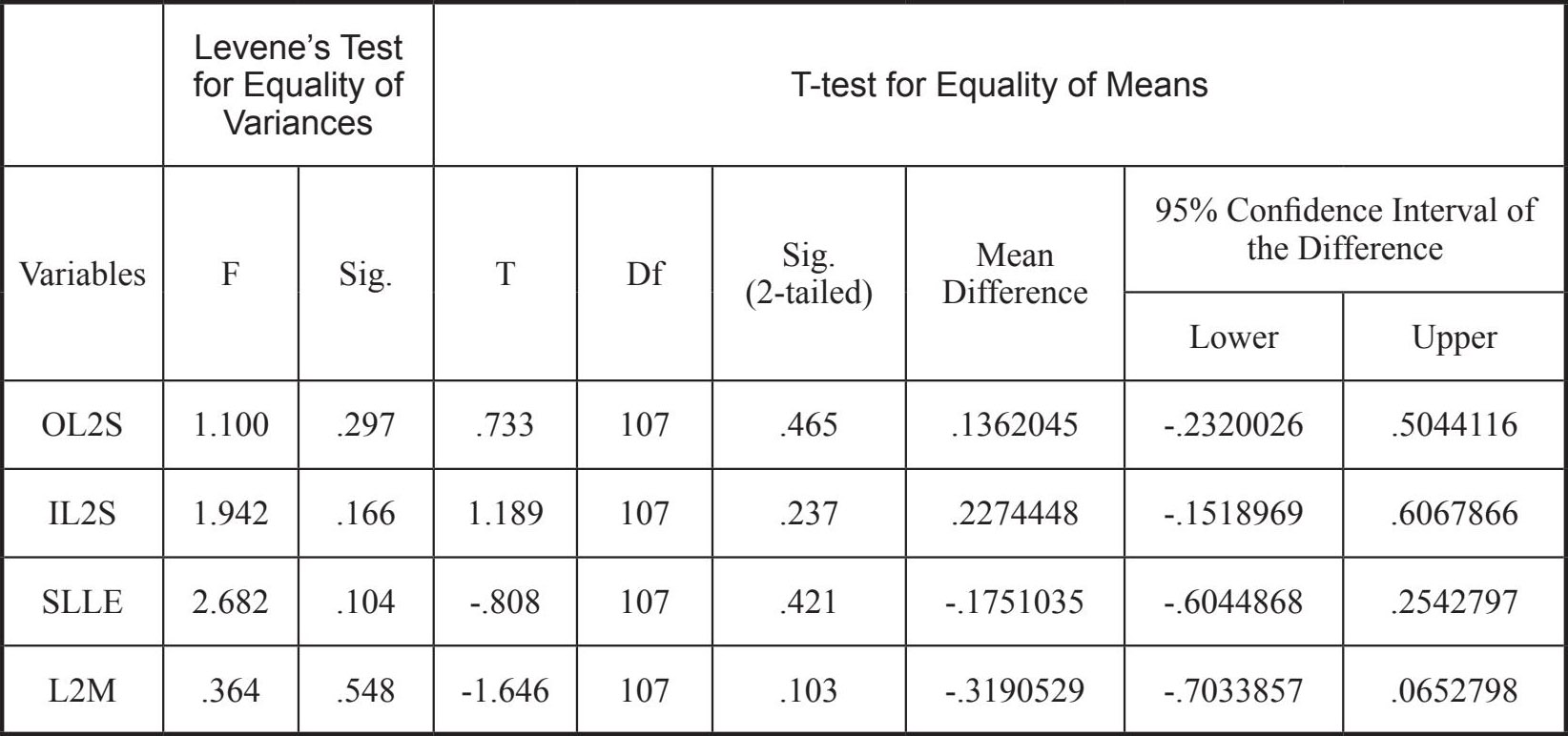
For Levene’s Test for Equality of Variances, the significant values of the four variables were.297, .166, .104, and .548 respectively, which were all higher than 0.05, suggesting that variables were homogenous between the two groups. Moreover, for the T-test for Equality of Means, the significant values with two tails of the four variables (.465, .237, .421 and .103) were all larger than 0.05. Therefore, the independent samples T-test results showed that there was no significant difference between the two groups in the L2MSQ Pretest. And the two groups could be regarded as reliable subjects for the research.
Secondly, to gain keen insights into the study, the results of L2MSQ before the training and after the training in the control group were investigated. But only 49 of the 55 questionnaires were collected, so only 49 cases were captured by the system in the way of Paired Samples T-test in the control group. The results are listed as follows:
The table reveals that some variables became higher while some got lower at the same time in the control group. For example, the OL2S was 0.1395 higher (3.506806-3.367343) in the post-test; the IL2S became higher as the mean was 4.425659 in the post-test compared to the mean 4.365888 in the pre-test; the SLLE in the pre-test was 3.832653 but 3.614976 in the post-test; the L2M in the pre-test was 3.976190 and 3.810739 in the post-test. Moreover, the mean differences between the pre-test and post-test in the control group are in Table 3.4.
Table3.3 Paired Samples Statistics of L2MSQ in the Control Group
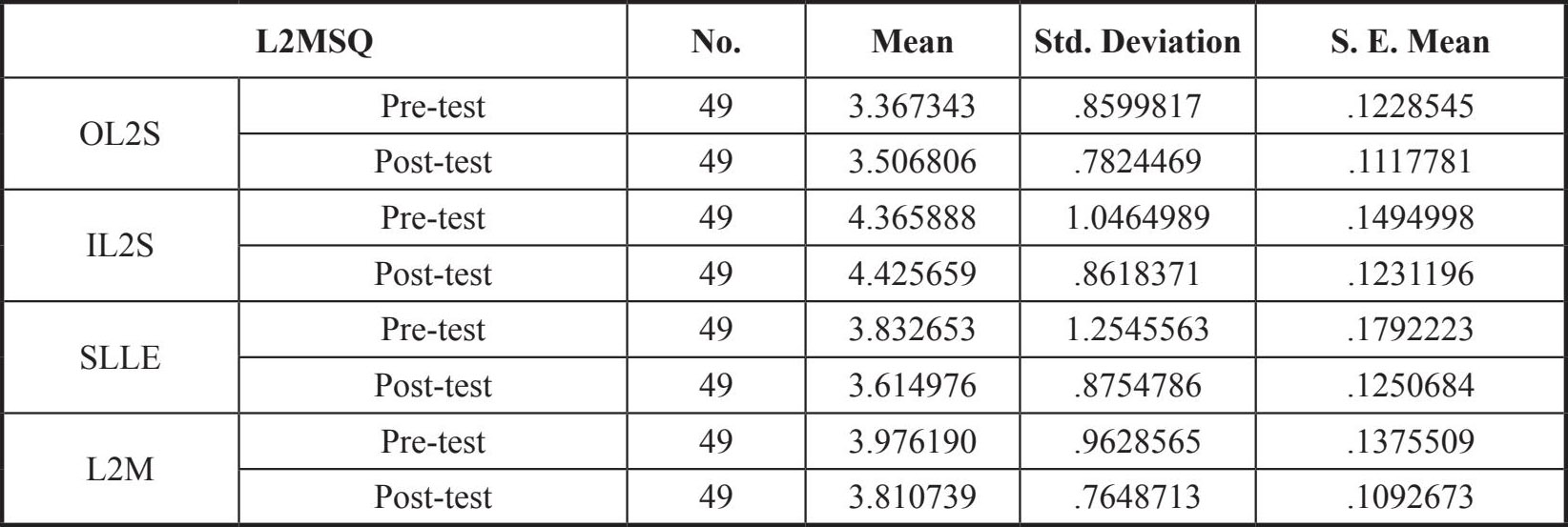
Table3.4 Paired Samples T-test of L2MSQ in the Control group

Note: 1: pre-test; 2: post-test
The table suggests that the outcome of the four variables in the control group did not change significantly after the training. Particularly, the significant values of the OL2S, IL2S, SLLE and L2M were .381, .754, .305 and .309 respectively and all of them were higher than 0.05. So the four variables of L2MSQ in the control group stayed nearly at the same level during the training.
Thirdly, the results of the experimental group before the training and after the training were surveyed in the following part. But only 51 reliable questionnaires were collected, so 51 cases were run by the Paired Samples T-test after the information is input into the system.
Table3.5 Paired Samples Statistics of L2MSQ in the Experimental Group
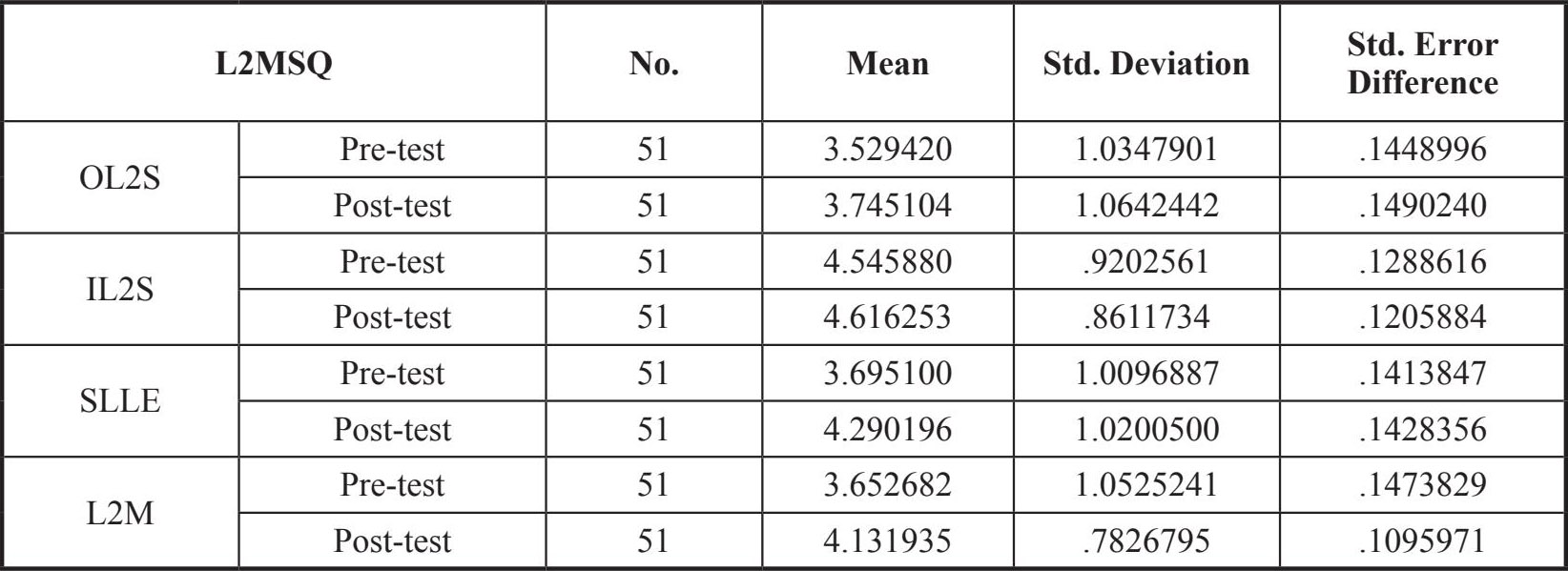
The result revealed that the mean of the four variables in the experimental group increased after the motivational training to some extent. The mean of the OL2S was 3.529420 in the pre-test but 3.745104 in the post-test; the value of IL2S in the post-test rose by 0.0704; the mean of SLLE was 3.695100 in the pre-test and 4.290196 in the post-test; the mean of L2M went up by 0.4793 after the motivational training.
Table3.6 Paired Samples T-test of L2MSQ in the Experimental Group
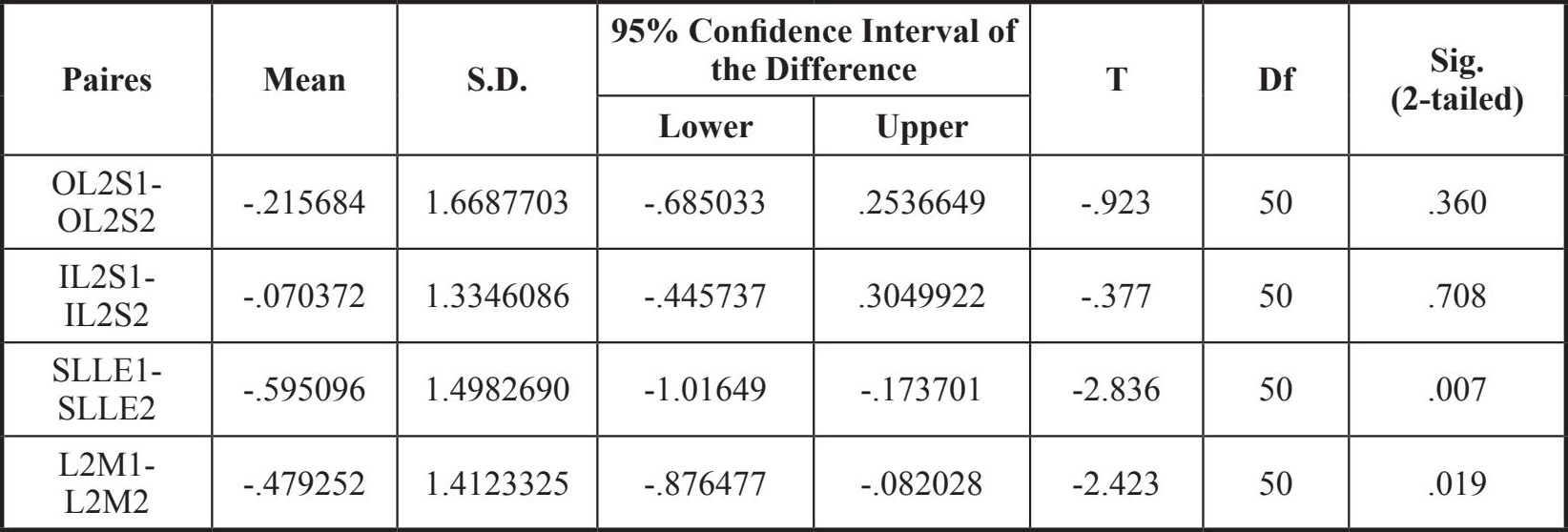
Note: 1 is for Pre-test; 2 is for Post-test
As shown in Table 3.6, the significant value of OL2S was .360, indicating that there is no significant difference (T=-.923; .360>0.05); there was no significant difference in the IL2S between the pre-test and post-test (T=-377; .708>0.05); the significant value of SLLE was .007,lower than 0.05 and significantly different; there was significant difference in the L2M after the training (T=-2.423; .019<0.05). So the variables of OL2S and IL2S were not significantly different after the training but SLLE and L2M were improved dramatically under the effects of motivational teaching strategies on learners’ ideal L2 self as they became significantly different.
Fourthly, to further verify if there were significant differences between the two groups in the post-test, the method of the independent samples T-test was executed for the L2MSQ Post-test variables. The results are shown below:
Table3.7 Independent Samples Statistics of L2MSQ Post-test Between the Two Groups
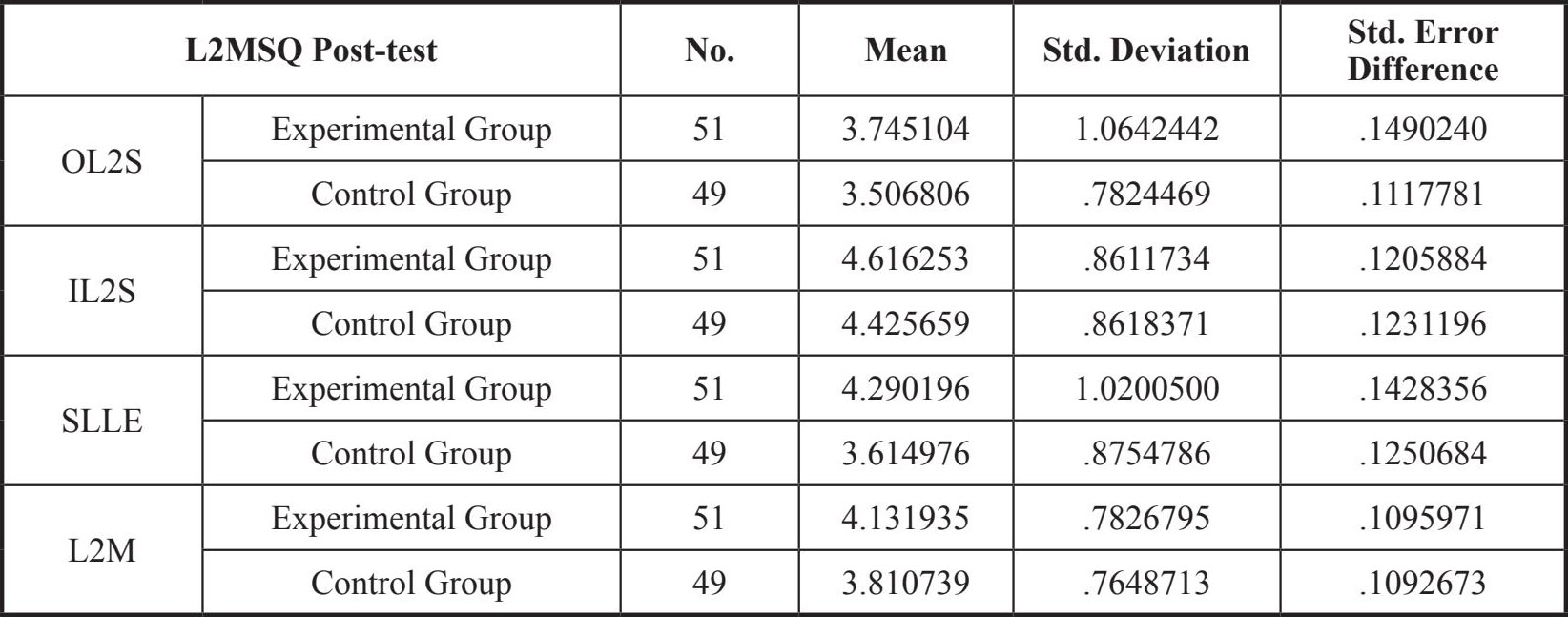
The results of L2MSQ post-test suggested that the four variables were higher in the experimental class than those in the control class after nearly one year’s motivational teaching training that exerted influence on their ideal L2 self. The mean of OL2S in the experimental group increased by 0.2382; the mean of IL2S in the experimental group rose by 0.1906; the mean of SLLE in the experimental group was elevated by 0.6752; the mean of L2M in the experimental group went up by 0.3212. But it is too early to state that the four variables are all significantly different from those in the control group.
Table3.8 Independent Samples T-test of L2MSQ Post-test Between the Two Groups
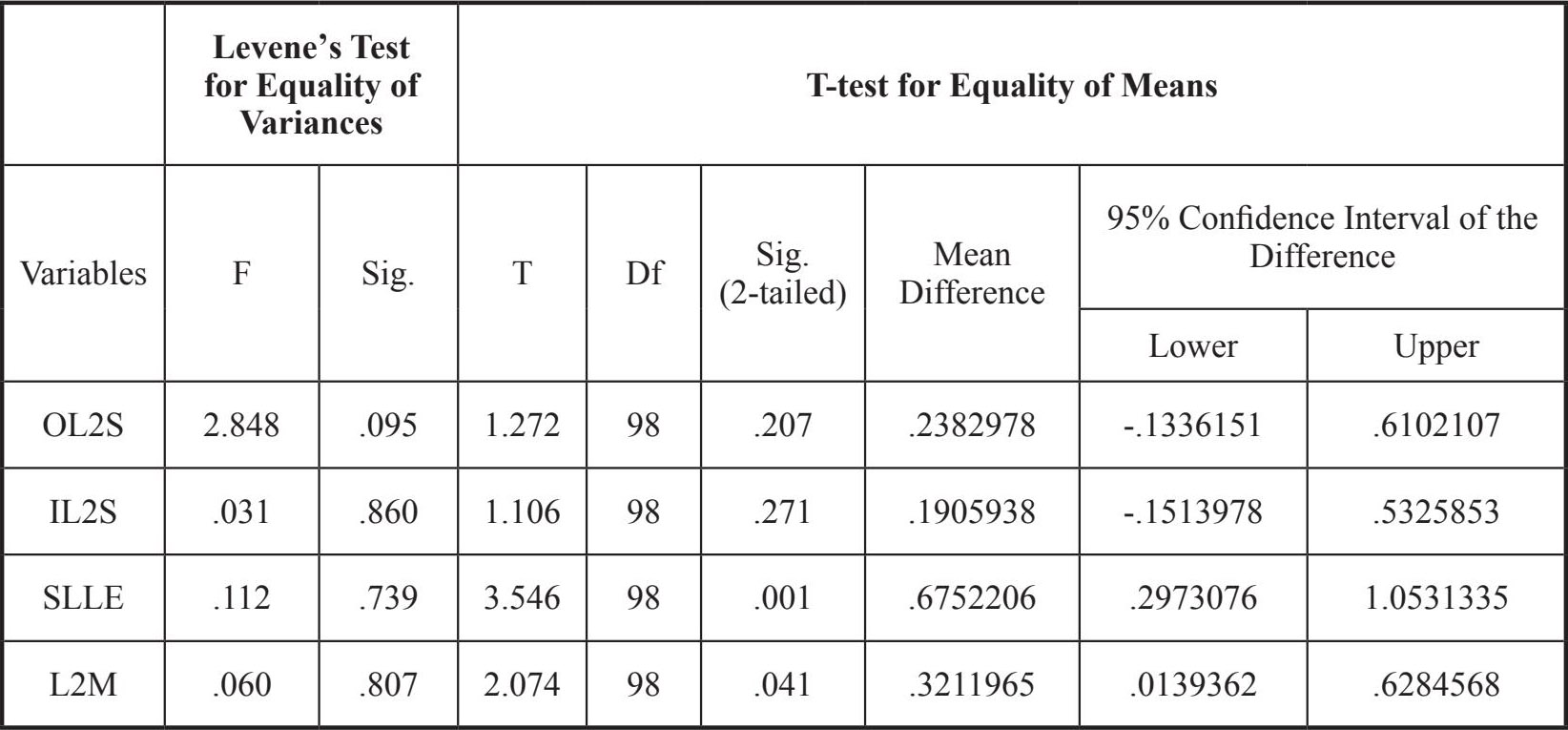
As shown by Table 3.8, all the four variables in the Levene’s Test for Equality of Variances were above 0.05, pointing to homogeneity across the experimental group and the control group. The T-test for Equality of Means showed that two variables became larger than 0.05 and the other two were smaller than 0.05. The smallest value lay in SLLE with T=3.546 and P=.001<0.05, illustrating significant differences; the second smallest value lay in L2M with T=2.074, P=.041<0.05, indicating significant differences; the significant value of OL2S was .207(P=.207>0.05) with T=1.272, showing no significant difference; the significant value of IL2S was.271 (P= .271 >0.05) with T=1.106, showing no significant difference.
The Motivational Teaching Strategy (MTS) includes two parts, namely, the micro teaching strategies and the macro teaching strategies. They have been explored to stimulate subjects’ self-adjustable learning and have been proved to exert effect on students’ regulatory capacity. But what kind of feeling did the subjects perceive on motivational teaching strategies? More evidence should be analyzed to answer this question and to find out whether the effect of motivational teaching strategies is positive and even far-reaching.
Firstly, the pre-test of motivational teaching strategies was performed and the results are listed as follows:
Table3.9 Independent Samples Statistics of MTS Pre-test between the Two Groups

The table above illustrated that the values of both the micro strategies and the macro strategies in the experimental group were higher than those in the control group. The mean values of the micro and macro strategies in the experimental group were 3.707716 and 3.719943;while the mean values of the micro and macro strategies in the control group were 3.582115 and 3.611604.
Table3.10 Independent Samples T-test of MTS Pre-test Between the Two Groups

For the Levene’s Test for Equality of Variances, they were homogeneous across the two groups as their significant values were higher than 0.05 (Micro: P=.109; Macro: P=.061). As for the T-test for Equality of Means, their significant values were both higher than 0.05 (Micro:T=1.515, P=.133; Macro: T=1.268, P=.208), revealing no significant difference between the two groups in the pre-test.
Secondly, paired samples T-test was conducted for the control group in order to determine whether the motivational teaching strategies are used more frequently or not. But 52 questionnaires were collected in the post-test with one incomplete, so 51 cases wee analyzed in the SPSS 18.0 for the paired ones at random. The results are listed below:
Table3.11 Paired Samples Statistics of MTS in the Control Group

The mean values of both the micro and the macro motivational teaching strategies increased in the post-test as the micro motivational teaching strategies in the pre-test were 3.576465 but 3.771896 in the post-test; the macro motivational teaching strategies in the pre-test were 3.612212 but 3.722775 in the post-test.
Table3.12 Paired Samples T-test of MTS in the Control Group

Note: MI refers to micro; MA refers to macro; 1 is for pre-test; 2 is for post-test
The most appealing information provided in the above table lies in the micro motivational teaching strategies, as a significant value was obtained (T=-2.117, P=.039<0.05), confirming that the micro motivational teaching strategies are used more frequently; but the significant value of the macro motivational teaching strategies was .234 >0.05, indicating that there was no significant difference and the macro motivational teaching strategies were used at pretty much the same level both before and after the training.
Thirdly, 51 Motivational Teaching Strategy Questionnaires were collected in the experimental group in the post-test. Paired sample T-test was applied to find out whether the use of micro and macro motivational teaching strategies became significantly different after the training in the experimental group.
Table3.13 Paired Samples Statistics of MTS in the Experimental Group

Both the values of micro and macro motivational teaching strategies become higher after the training and their values of Std. Error Difference are not large. The micro values are 3.731045 in the pre-test while 3.998371 in the post-test; the macro values are 3.740720 in the pre-test while 4.005284 in the post-test.
Table3.14 Paired Samples T-test of MTS in the Experimental Group

The statistics show that both the values of micro and macro motivational teaching strategies were significantly different as they were below 0.05 (Micro: T=-2.715, P=.009<0.05; Macro:T=-2.635, P=.011<0.05), indicating that motivational strategies were used more frequently in the post-test in the experimental group.
Fourthly, the motivational teaching strategies post-test was conducted using the method of independent samples T-test in order to confirm whether its variables reached a significant level in the experimental group compared to the control group and whether the motivational teaching strategies were employed more frequently in the experimental group from the perspective of subjects. The results are listed below:
Table3.15 Independent Samples Statistics of MTS Post-test Between the Two Groups

It can be observed that variables of motivational teaching strategies are higher in the experimental group than those in the control group. It tells the motivational teaching strategies in the experimental group are more popular than in the control group.
Table3.16 Independent Samples T-test of MTS Post-test Between the Two Groups

The data in the table above suggest that the two variables of the motivational teaching strategies became significant in the post-test as the amount of micro strategies was lower than 0.05 (T=2.156, P=.034<0.05; T=2.668, P=.009<0.05), which indicated that motivational teaching strategies were used more frequently in the experimental group than in the control group. The outcome revealed that the motivational teaching strategies were employed more often to motivate subjects in the experimental group although the use of motivational strategies was also improved to some extent in the control group.
Therefore, it can be concluded that learners’L2 motivation in the experiment has been improved as the significant value of L2M becomes significant both in the paired dependent samples T-test and the independent samples T-test of the post-test. However, the results in this paper are a little different from those in Dr. Liu Fengge’s findings that all the four variables (OL2S,IL2S, SLLE, and L2M) in the post-test become significantly different. Only variables of SLLE and L2M are significantly different in this paper.
Based on the results of questionnaires mentioned above, it can be seen that the effects of motivational teaching strategies on non-English majors’ ideal L2 self are dramatic.
Firstly, when motivational teaching strategies are used to influence subjects’ ideal L2 self,most of the students in the experimental group set their short-term and long-term objectives,which energize and remind them to compete and fight for their L2 dreams; subjects’ perception of motivational teaching strategies in the experimental group is more vivid and influential, so the frequency of using the motivational teaching strategies is found higher in the experimental group before and after the training and in the control group after the training.
Secondly, given the effects of motivational teaching strategies on non-English majors’ ideal L2 self, the four variables of L2MSQ have been improved a great deal after the training in the experimental group, especially the L2M and SLLE become significant at the 0.05 level, and values of OL2S and IL2S have been increased too, by .21568 and .0704 respectively. So not only L2M has been improved by the motivational teaching strategies but all the other three variables have been enhanced to a different extent.
Therefore, it is necessary and worthwhile to do this research but more practical experiments should be conducted in different situations and with a large number of learners in order to supplement this study.
1. Dörnyei, Z. 2003. Attitudes, Orientations and Motivations in Language Learning: Advances in Theory,Research and Applications [J]. Language Learning (Supplementary Issue) , 3-32.
2. Dörnyei,Z. 2005. The Psychology of the Language Learner: Individual Differences in Second Language Acquisition [M]. Mahwah, NJ: Lawrence Erlbaum Associates,66-67.
3. Dörnyei, Z. 2009. The Psychology of Second Language Acquisition [M]. Oxford: Oxford University Press, 108.
4. Cheng, H. F. & Dörnyei, Z. 2007. The Use of Motivational Strategies in Language Instruction: The Case of EFL Teachingin Taiwan[J]. Innovation in Language Learning and Teaching (1), 153-174.
5. 李绍鹏,杨连瑞. 2012. 二语习得动机理论研究新进展[J].外语学刊(5),43-46.
6. 刘凤阁. 2010. L2MSS理论视角下的中国二语学习者动机研究[D]. 上海外国语大学博士论文,228-229.